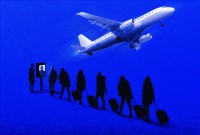- Home
- Business Processes
- Industry Knowledge
- Aerospace Industry
- Automotive Industry
- Banking Domain
- BFSI Industry
- Consumer/ FMCG Industry
- Chemicals Industry
- Engineering & Construction
- Energy Industry
- Education Domain
- Finance Domain
- Hospitality Domain
- Healthcare Industry
- Insurance Domain
- Retail Industry
- Travel and Tourism Domain
- Telecom Industry
- Leadership Skills
- eLearning
- Home
- Industry Knowledge
- Aerospace Industry
- Application of Aviation in Military – A Short History
Application of Aviation in Military – A Short History
Aerospace is an industry that has a history of about a century in the defense space. This article discusses how the historic flight of the Wright brothers in 1908 gave birth to the aerospace defense industry that today employs 850K people in the US only.
One hundred years have now elapsed since the Wright brothers' crude airplane, propelled by a 12-horsepower petrol engine, performed the astonishing feat of staying aloft for some 40 meters. Through this achievement, one of the greatest and most enduring dreams of humankind – to conquer the heavens - was finally fulfilled. Any innovation in aerospace would have military applications had long been recognized and today the US Federal government employs an estimated 850K aerospace and defense skilled workers at armed forces maintenance and repair depots and other defense agencies. Armed conflict has always been a catalyst for technological development, and the effect of war on aircraft development has been profound.
Early Navigable Balloons and Airships:
The defense industry has its origins in antiquity with the use of primitive weapons such as catapults, bow and arrow, the invention of gunpowder, and the subsequent development of guns and cannons. Exploring other air transportation means for military purposes has been an even prevalent event before this historic event.
Balloons which are lighter than air had been intermittently employed in warfare since the 1790s, usually as moored observation platforms. The biggest disadvantage with them was that they were at the mercy of the prevailing wind. In the Battle of Fleurus in 1794, the French successfully used the observation balloons to watch Austrian troop movements.
The first attempts to add some form of the steering system and propulsion unit were made as early as the mid-1800s but without much success. By 1900, Count Ferdinand von Zeppelin had refined this concept, producing the rigid, navigable airships which were inflated using hydrogen which is a highly inflammable gas. These units were typically 450 feet (150 m) long and, driven by several small engines and were capable of achieving speeds of up to 47 mph (75 km/hour) and can fly up to altitudes of 6,000 feet (1,828 m).
Initially used for travel and transportation, they were adapted for military purposes for the first time during the First World War for dropping high-explosive and incendiary bombs on various towns in Britain and France.
From First Flight to First Bomb Droppings:
Orville Wright's cursory flight of December 1903 did not attract very much attention, and two years were to pass before he and his brother, Wilbur, had refined their primitive plane sufficiently for it to be able to stay aloft for distances of up to 24 miles (38 km). In fact, it was only in 1908, when they brought their aircraft to Europe and Wilbur performed several flights for all to see, that public enthusiasm and interest were kindled. The following year witnessed not only Louis Bleriot's flight over the Channel, which was accomplished at an average speed of 40 mph (64.36 kmh), but also that a French pilot achieved a speed of 50 mph (80.45 kmh) and thus set a new world record. In 1910 Curtiss began a sequence of trials in which he sought to hit targets from the air, including ships, with either dummy or live bombs. Dependable bomb-sights were a prerequisite for success, and his experiments marked the start of what was to prove a lengthy quest for such devices. Nevertheless, bombs were first to be dropped in anger as early as 1911. During that year, the Tripolitan War between Italy and the Ottoman Empire broke out when the former sought to wrest control of Libya from the Porte. This confrontation saw the very first use of airplanes in combat, the Italians employing a handful of them to observe and attack their Turkish adversaries.
Britain’s Royal Air Force:
Samuel Franklin Cody helped design and build the UK's first officially recognized airplane in October 1908, and in the same year, USA also ordered its first aircraft - from the Wright brothers - for military use. Britain's Royal Air Force (RAF) - the world's first independent air force - was established in 1918, its trappings and equipment comprised a telling blend of cutting-edge technology and venerable martial customs. Within a few years of being adapted for military purposes, airpower had become an advantage for those who own it. RAF was the first force of its kind in the world and was supported by an equally unique air ministry that was set up in December 1917.
Cold War & Aerospace Industry:
Post World War II, the development of military aviation was spurred less by massive military conflict and more by the tense stand-off between superpowers during the Cold War. The helicopter began to appear at the end of World War II and eventually matured into an indispensable part of military aviation. The need to continue to out-perform potential opponents gave rise to rapid development in new technologies and aircraft designs. The 1980s through to the present day were characterized by incredible advances in electronics, stealth technology, and both offensive and defensive systems. Today, a country's military aviation forces are often the first line of defense against an attack, or the first forces to attack an enemy. The capability of military aviation forces (or lack thereof) has proved decisive in several recent conflicts such as the Gulf War.
Impact of Aerospace & Defense Industry:
The aerospace industry has transfigured everyday life as well as warfare. The first commercial flights began in Florida in 1914 and, after the First World War; the number of operating companies and routes began to mushroom. Since the first powered flight by the Wright Brothers on December 17, 1903, a little over a century ago, the aerospace and defense industry has changed the very nature of business and leisure travel as well as armed conflict. Throughout history, the defense industry, and later the commercial and military aerospace and defense industry, have played a key part in human evolution, intertwined with economic growth. Game-changing technology innovations were created, such as the jet engine, supersonic flight, space flight, radar, communications, direct-to-home television broadcast, and GPS navigation satellites, and the development of the internet. The Apollo moon mission, culminating in the first man to land on the moon on July 20, 1969, was probably one of the most iconic moments in the development of the aerospace industry, only 66 years after the Wright Brothers’ first flight.
Suggested Reading and Resources
Related Links
You May Also Like
-
Application of Aviation in Military – A Short History
Aerospace is an industry that has a history of about a century in the defense space. This article discusses how the historic flight of the Wright brothers in 1908 gave birth to the aerospace defense industry that today employs 850K people in the US only.
-
Civil Aviation Sector – A brief History
The civil aviation sector has transformed itself during the last hundred years. There has been massive technological development in passenger traffic and comfort and now the civil aviation industry accounts for approximately 30% of the overall aerospace industry. A brief account of civil aviation history is presented in this article.
-
Civil Aerospace: Commercial Avionics Industry
Commercial avionics refers to cockpit electronics and airborne equipment, although it doesn't include antennas, recorders, or other passenger-only cabin systems. Avionics is referred to denote the electronic systems that are utilized in aircraft.
-
Civil Aerospace Sector - Sector Profile
In this article, we will discuss the four important sub-sectors of the Civil Aerospace Sector namely “Civil Aircraft Manufacturing”, “Commercial Avionics”, “MRO” and “Commercial Simulation & Training”.
-
Aerospace Industry: The Business Model
In this article, we will discuss the value chain of the Aerospace Industry and will define the generic business model to understand the key process areas in the aerospace industry. This will provide you with a basic understanding of key activities in the industry.
-
Civil Aerospace: Civil Aircraft Manufacturing Industry
This article discusses sectors within the Civil Aerospace Sector and its subsectors, products, and services. This article provides an overview of the definition, industry products, industry activities, and global locations.
-
Military & Defense Aerospace Sector – Sector Profile
In this article, we will discuss the important sub-sectors of the Military & Defense Aerospace Sector namely military aircraft manufacturing and military avionics, maintenance, repair, and overhaul (MRO), missiles, C4ISR, and related services and modeling, simulation, and training.
-
Aerospace Industry - The Competitive Landscape
This article provides an overview of the competitive landscape of the aerospace industry. Read how the compaction is shaped up across the US and the globe, followed by a detailed discussion of the top 5 players in the sector in terms of revenue.
-
An overview of the Aerospace Industry. A brief account of how modern aerospace began way back with Sir George Cayley in 1799 and the success story of the Wright Brothers to today's massive international airspace developments.
-
Civil Aerospace - Commercial Simulation and Training
Training people how to operate and maintain today’s sophisticated aircraft as well as on-board and ground support systems can be very complex and costly. To be effective, the training environment must accurately simulate the features and capabilities of the actual systems in a wide range of operating scenarios. Commercial modeling, visual simulation, flight simulation, and computer-based training are the key methods used by this subsector.
Explore Our Free Training Articles or
Sign Up to Start With Our eLearning Courses

About Us
Learning
© 2023 TechnoFunc, All Rights Reserved









